Images & Maps
Note: These images are National Archives photos (courtesy of the Gallery of the Open Frontier) dating from the 1860s through the 1890s—long after the Corps of Discovery passed through the homelands of the Native nations that are depicted. The images are included to give a sense of the vibrancy and enduring nature of the Native cultures the expedition encountered. Despite many far-reaching and often tragic changes that occurred in the decades following the Corps of Discovery's travels, these cultures persisted. The images do not, of course, represent actual individuals or villages encountered by the expedition.

Arapaho Camp.

Arapaho Camp, 1868 (pencil notation reads, 'Comanche')

Cheyennes and Arapahos at Seger Colony. As they lived in 1886.

Scene during the Sioux Campaign. Assinniboine Indians, MT.

Assinniboine Indian family and teepee, MT.

Assinniboine Indians, MT.

Assinniboine Indians, MT.

Assinniboine Indians.

An Assinniboine Indian—MT.
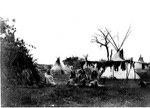
Cheyenne Lodges with buffalo meat drying. (Pencil Notation Reads: "William S. Soule" and "Arapaho camp near Fort Dodge, Kansas").

Flatmouth, Head Chief of the Leech Lake band Chippewas.

Castle Rock or "McLeod's Castle," right bank of Columbia River. (Cascades of the Columbia)

Cascade on left bank Columbia River (Cascades of the Columbia)

Group of Crow Indians seated in front of a tepee.

Flathead Indian Family

Great Missouri Falls in 1867—now called the great falls of Missouri.

Pacer (Peso, Essa-queta), a Kiowa-Apache chief; wearing earrings.

Mandan and Arikara delegation

Looking Glass, a Nez Perce chief, on horseback in front of a tepee

Pawnee and home

Chief Washakie (Shoots-the-Buffalo-Running) of the Shoshones.

Bird's eye view of Sioux camp at Pine Ridge, SD.

Indian War Photograph. A Sioux Indian village.

Sioux village on Laramie River - Nebraska.
Note: These images are provided by the Library of Congress.

Several Atsina on horses with travois behind them, tipis in background.

Tlakluit Indian, standing on rock, fishing with dip net.

Mandan bull boat

New Chest, half-length portrait, facing forward.

Tlakluit woman, half-length portrait, facing front, wearing a heavily beaded buckskin dress, several necklaces, beads, shells, dentalium-shell nose ornament and a headdress of beads and hollow-centered Chinese coins.

Tipis on plains.

Lissle Plume (r) and son Yelloe Kidney (c) seated on ground inside tipi, with woman.

Indian woman holding rushes.

Bear's Teeth, Arikara, head-and-shoulders portrait, facing front, wearing headband.
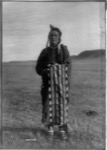
Hidatsa Indian posed, standing, full-length, draped with blanket, facing front; with mountain in background. "Holds the Eagle" on verso.

Hidatsa Indian posed, head and shoulders, facing right.

Hidatsa Indian woman posed, head and sholders, facing front. "Mrs. White Duck" on verso.

Atsina Indian on horse pulling travois

Salish Indian boy, posed, wearing costume and headdress.
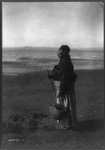
American Indian woman standing holding a basket on beach.

Lewis and Clark's landing place at Nihhluidih. Chinook Indian standing on river bank, Columbia River Valley.
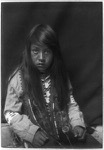
Portrait of a Yakima boy, half-length, seated, with loose hair, a cloth shirt, shell beads, and a fur strip around his shoulders.

Photograph shows reed mat covered tepee in grassy field, Washington.

Chinookan Indians: Tlakluit; Washington. Landscape, portrait, woman, full length, facing right, standing, wearing beaded buckskin dress.

Half-length portrait of Indian with decorated face, feather and bead ornaments, seated, facing right, The Dalles, Oregon.

Rattles of Arikara bear medicine men.

Arikara woman, half-length portrait, facing front.

Indian, three-quarter length portrait, seated, facing right, in native dress.

Studio portrait of an Indian, possibly Salish (Flathead), half-length, seated, facing right, wearing feathered headdress.

Native with dugout canoe — Celilo-Columbia River, 1897 / [Gi]fford, The Dalles, Or. Indian, possibly Wasco, seated on a long canoe.

Po-ca-tel-lo, Yakima or Umatilla Indian, from Oregon, half-length portrait, facing right.
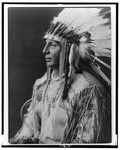
White Shield, Arikara, half-length portrait, facing left.

Walter Iron Shell, Lakota, Sioux tribe, half-length portrait, facing front in traditional clothing.

Walter Iron Shell, Lakota or Sioux tribe, half-length portrait, facing right, in traditional clothing.

Crow chief, half-length portrait, facing right.

Black Eagle, full-length portrait, standing, facing front, wearing buffalo hide, holding wing of bird.

Red Whip, Atsina man, half-length portrait, seated, facing front, wearing feather, beaded buckskin shirt, holding pipe in left hand.

Bear's Belly, Arikara Indian, half-length portrait, facing front, wearing buckskin

Bear Legs, an Osage Indian, half-length portrait, seated, facing front.

Joseph Dead Feast Lodge—Nez Percé
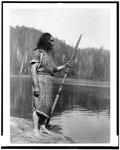
Nootka Indian standing on shore with spear.

Piegan girl standing in doorway of tepee, wearing beaded buckskin dress, Montana.
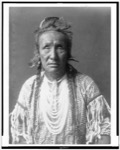
The Grizzly Bear, Piegan, half-length portrait, facing front.

Running Owl's family (Piegan), adult woman and two daughters seated on rug floor of lodge, wearing beaded cloth dresses.

A Young Arikara Indian stands in shallow water, wearing buckskin dress, with trees in background, North Dakota.
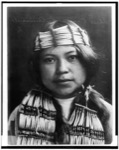
Young Indian (Quinault), head-and-shoulders portrait, facing front, wearing shell ornaments.

Wades in Water, Piegan Indian, full-length portrait, seated on floor, facing front, with braids, beaded buskskin shirt and leggings, beads with ermine tail trim.

Three Eagles, a Nez Percé man, head-and-shoulders portrait, facing left.

Piegan woman, half-length portrait, seated, facing front, wearing headdress made of ermine tails, feathers, and bunches of grass.
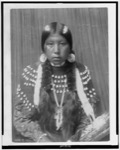
Kalispel Indian woman, half-length portrait, facing front, seated, wrapped braids, white stripes painted on hair, shell disk earrings, wearing blanket dress decorated with elks' teeth.
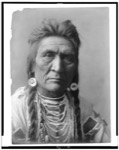
Head-and-shoulders portrait of a Crow man.

Piegan woman seated on ground in open field.

Three-quarter length portrait of Piegan family.

Siksika man with calumet and young boy inside tipi.

Earthen lodge, with bull boat by doorway, North Dakota.

Yellow Horse—Yanktonai, half-length portrait, standing, facing slightly right, with long braids, two eagle feathers in hair, wrapped in buffalo skin.

Nez Percé man, head-and-shoulders portrait, facing front, wearing bead necklack, with blanket over shoulder.

Standing Buffalo, Winnebago man, reclining on ground, rifle across leg

Winnebago man, three-quarter length portrait, facing front, seated, wrapped in blanket.
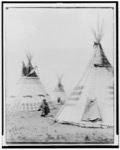
Woman walking among painted tipis.

Dakota man, half-length portrait, facing front.

Yakima woman, half-length portrait, facing front.

Susie Shot in the Eye, a Sioux Indian, half-length portrait, seated, facing left, at the Indian Congress of the Trans-Mississippi and International Exposition.

Piegan woman, full-length portrait, seated on blankets inside tipi(?), facing front.

Wishham Petroglyphs.

Eagle Child, Atsina man, half-length portrait, facing front.
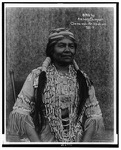
Yurok author, Lucy Thompson, half-length portrait, seated, facing slightly right.

Elk Tongue (Scout Mobiel?), wearing war bonnet while carrying shiled and bow, on horseback, facing right.

Three Arikara men, members of the medicine fraternity, dancing, painted to represent ducks and holding rushes.
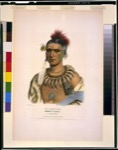
Ma-Has-Kah or White Cloud, an Ioway chief, head and shoulders portrait, facing slightly left.

Shout-At, half-length portrait, facing left, wearing breastplate and war bonnet.

Hoo-Wan-Ne-Ka, half-length portrait, facing right, holding tomahawk.

Payta-Kootha, a Shawanoe warrior, head-and-shoulders portrait, facing slightly right / drawn, printed and coured at I.T. Bowen's Lithographic Establishment.

Tah-Ro-Hon — an Ioway warrior, half-length portrait, facing left, holding calumet (peace pipe), wearing medallion / drawn, printed & coloured at I.T. Bowen's Lithographic Establishment
 Cheyenne Lodges with buffalo meat drying. (Pencil Notation Reads: "William S. Soule" and "Arapaho camp near Fort Dodge, Kansas").
Cheyenne Lodges with buffalo meat drying. (Pencil Notation Reads: "William S. Soule" and "Arapaho camp near Fort Dodge, Kansas").
 Tlakluit woman, half-length portrait, facing front, wearing a heavily beaded buckskin dress, several necklaces, beads, shells, dentalium-shell nose ornament and a headdress of beads and hollow-centered Chinese coins.
Tlakluit woman, half-length portrait, facing front, wearing a heavily beaded buckskin dress, several necklaces, beads, shells, dentalium-shell nose ornament and a headdress of beads and hollow-centered Chinese coins.
 Hidatsa Indian posed, standing, full-length, draped with blanket, facing front; with mountain in background. "Holds the Eagle" on verso.
Hidatsa Indian posed, standing, full-length, draped with blanket, facing front; with mountain in background. "Holds the Eagle" on verso.
 Lewis and Clark's landing place at Nihhluidih. Chinook Indian standing on river bank, Columbia River Valley.
Lewis and Clark's landing place at Nihhluidih. Chinook Indian standing on river bank, Columbia River Valley.
 Portrait of a Yakima boy, half-length, seated, with loose hair, a cloth shirt, shell beads, and a fur strip around his shoulders.
Portrait of a Yakima boy, half-length, seated, with loose hair, a cloth shirt, shell beads, and a fur strip around his shoulders.
 Chinookan Indians: Tlakluit; Washington. Landscape, portrait, woman, full length, facing right, standing, wearing beaded buckskin dress.
Chinookan Indians: Tlakluit; Washington. Landscape, portrait, woman, full length, facing right, standing, wearing beaded buckskin dress.
 Half-length portrait of Indian with decorated face, feather and bead ornaments, seated, facing right, The Dalles, Oregon.
Half-length portrait of Indian with decorated face, feather and bead ornaments, seated, facing right, The Dalles, Oregon.
 Studio portrait of an Indian, possibly Salish (Flathead), half-length, seated, facing right, wearing feathered headdress.
Studio portrait of an Indian, possibly Salish (Flathead), half-length, seated, facing right, wearing feathered headdress.
 Native with dugout canoe — Celilo-Columbia River, 1897 / [Gi]fford, The Dalles, Or. Indian, possibly Wasco, seated on a long canoe.
Native with dugout canoe — Celilo-Columbia River, 1897 / [Gi]fford, The Dalles, Or. Indian, possibly Wasco, seated on a long canoe.
 Walter Iron Shell, Lakota or Sioux tribe, half-length portrait, facing right, in traditional clothing.
Walter Iron Shell, Lakota or Sioux tribe, half-length portrait, facing right, in traditional clothing.
 Black Eagle, full-length portrait, standing, facing front, wearing buffalo hide, holding wing of bird.
Black Eagle, full-length portrait, standing, facing front, wearing buffalo hide, holding wing of bird.
 Red Whip, Atsina man, half-length portrait, seated, facing front, wearing feather, beaded buckskin shirt, holding pipe in left hand.
Red Whip, Atsina man, half-length portrait, seated, facing front, wearing feather, beaded buckskin shirt, holding pipe in left hand.
 Running Owl's family (Piegan), adult woman and two daughters seated on rug floor of lodge, wearing beaded cloth dresses.
Running Owl's family (Piegan), adult woman and two daughters seated on rug floor of lodge, wearing beaded cloth dresses.
 A Young Arikara Indian stands in shallow water, wearing buckskin dress, with trees in background, North Dakota.
A Young Arikara Indian stands in shallow water, wearing buckskin dress, with trees in background, North Dakota.
 Wades in Water, Piegan Indian, full-length portrait, seated on floor, facing front, with braids, beaded buskskin shirt and leggings, beads with ermine tail trim.
Wades in Water, Piegan Indian, full-length portrait, seated on floor, facing front, with braids, beaded buskskin shirt and leggings, beads with ermine tail trim.
 Piegan woman, half-length portrait, seated, facing front, wearing headdress made of ermine tails, feathers, and bunches of grass.
Piegan woman, half-length portrait, seated, facing front, wearing headdress made of ermine tails, feathers, and bunches of grass.
 Kalispel Indian woman, half-length portrait, facing front, seated, wrapped braids, white stripes painted on hair, shell disk earrings, wearing blanket dress decorated with elks' teeth.
Kalispel Indian woman, half-length portrait, facing front, seated, wrapped braids, white stripes painted on hair, shell disk earrings, wearing blanket dress decorated with elks' teeth.
 Yellow Horse—Yanktonai, half-length portrait, standing, facing slightly right, with long braids, two eagle feathers in hair, wrapped in buffalo skin.
Yellow Horse—Yanktonai, half-length portrait, standing, facing slightly right, with long braids, two eagle feathers in hair, wrapped in buffalo skin.
 Nez Percé man, head-and-shoulders portrait, facing front, wearing bead necklack, with blanket over shoulder.
Nez Percé man, head-and-shoulders portrait, facing front, wearing bead necklack, with blanket over shoulder.
 Susie Shot in the Eye, a Sioux Indian, half-length portrait, seated, facing left, at the Indian Congress of the Trans-Mississippi and International Exposition.
Susie Shot in the Eye, a Sioux Indian, half-length portrait, seated, facing left, at the Indian Congress of the Trans-Mississippi and International Exposition.
 Elk Tongue (Scout Mobiel?), wearing war bonnet while carrying shiled and bow, on horseback, facing right.
Elk Tongue (Scout Mobiel?), wearing war bonnet while carrying shiled and bow, on horseback, facing right.
 Three Arikara men, members of the medicine fraternity, dancing, painted to represent ducks and holding rushes.
Three Arikara men, members of the medicine fraternity, dancing, painted to represent ducks and holding rushes.









































































